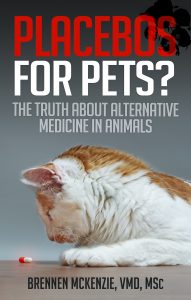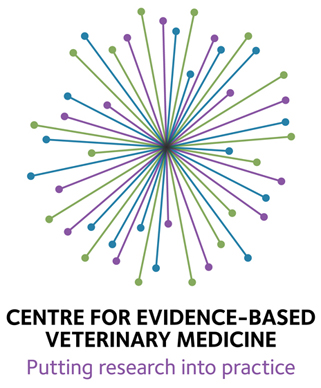I was recently asked to comment on an advertising card for Evolution Diet. There are a number of claims made, and because they are vague and wildly inflammatory, it is difficult to address them in an evidence-based manner, but I’ll do my best.
1. “Up to 30% Longer Life Expectancy”. This is in large, colored type adjacent to the name of the diet and a picture of a puppy and kitten. No evidence is presented on the card or the various websites associated with the company or the CEO Eric Weisman. Much is made of a couple of studies linking calorie restriction to some increase in life expectancy in various experimental animal studies. This is an interesting area of research, but it has no connection to the implied benefits of feeding this diet.
2. According to this advertisement, the pet food industry “provides a convenient way for the disposal of slaughterhouse toxic wastes unfit for human consumption” “hard to digest, nutrient deficient toxic ingredients include: intestines, udders, stomachs, lungs, heads…drugs and pharmaceuticals (antibiotics, hormones)…euthanized pets.”
A wild string of fallacies, nonsense, and outright lies. It is true that some parts of animals that people think of as icky are used to make pet food. But if lungs, intestines, stomachs, eyeballs and so on are all toxic, then why aren’t they poisoning all those cats who hunt rodents and birds, or for that matter every other carnivore that eats them routinely in the wild? Of course, Mr. Weisman would say they are, but the logic behind claiming that an obligate carnivore like a cat or ferret is healthiest if fed a vegan diet is bizarre and indefensible.
Antibiotics and drugs used in agricultural animals (which are then used to make pet food) are regulated very tightly because we eat the meat from these animals, and there isn’t any more of these things in the pet food that isn’t also in the steak we eat, which is to say little to none under normal circumstances. There are some real and serious issues about what we feed to animals intended for consumption, but these have little to do with the claims Evolution Diets makes.
The pentobarbital thing I addressed in my previous discussion of nutritional myths, and you can find the details on the FDA web site. In short, miniscule amounts were found in some (not “all”) foods tested, but no traces of dog or cat DNA were found in these foods, and there are separate companies and facilities involved in rendering companion animals and agricultural animals used to make pet food, so it’s pretty darned unlikely there are regularly pets in pet food. No one is sure where the pentobarbital comes from, but it’s possible a euthanized horse occasionally makes it into a rendering plant that provides ingredients for pet food. This is obviously not desirable, but it has also not been shown to represent a real health risk.
Is the amount of pentobarbital in some pet foods toxic? Pretty unlikely. The FDA calculated the maximum exposure and determined it was far too low to represent a danger. And contrary to what purveyors of the naturalistic fallacy generally think, dose matters in toxicology. Enough oxygen or water can kill you, though these are essential for life, and we all get tiny amounts of “natural” and synthetic substances in eating, drinking, and breathing all the time and always have. Common herbs and spices used in cooking have been linked to cancer, as long as they are fed in obscene amounts to rats. Does that mean we’re all going to die of oregano poisoning? It’s a big leap from saying tiny amounts of possibly toxic things are present to showing that there are health consequences to this, and this hasn’t been shown here.
3. “…millions of Dogs and Cats suffer and die each year from cancers, kidney/liver failure, heart disease, etc” and “scientific studies demonstrate that there are nutrient deficiencies for immune system, cardio-vascular and urinary tract precursor proteins in all basic meat, poultry, and fish-based pet foods.” I’d love to take a look at these studies, as I’m sure would all the veterinary nutritionists who don’t seem to be aware of them. AAFCO sets standards which all major manufacturers follow for nutrient content in foods, and I’m not aware of any evidence that every dog food made except this company’s is nutrient deficient and causes disease. The advertisement states the food is “complete and balanced for all life stages,” which at least claims compliance with AAFCO guidelines, just like every other commercial pet food.
As for the implication that cancer, kidney failure, liver failure, and heart disease in pets are somehow due to toxic ingredients or nutritional deficiencies in foods, well they just made that up. It is the most egregious kind of unfounded fear mongering with no evidence provided to support it.
4. “Literally, all major commercial pet food brands and suppliers, including most brand names, have been involved in major pet food recalls that have sickened and killed millions of Dogs and Cats in the U.S.” “Never a Recall!”
I’m not sure it’s possible to check the accuracy of these claims. Certainly, many pet foods have been recalled at one time or another, but I think it would be hard to show that all foods except this one have been. And the implication that this implies the foods are killing dogs and cats is nonsense. Most recalls are precautionary and no actual harm is ever found. And in those cases where some contaminate is actually present, a recall is an example of a responsible action that saves lives. The melamine incident, which I suspect is being referred to, involved a non-animal ingredient (what was supposed to be wheat protein but got adulterated with the melamine). Wheat and corn gluten meal are the first two ingredients on several of the Evolution Diets, and while I don’t know where they get these, the issue of contamination is just as likely to come up for this company as any other.
Interestingly, in 2003 a recall of Go! Natural pet food was conducted due to a number of cases of acute liver failure associated with the food. The underlying cause was never found, but the company manufacturing the food continues to tout it as healthier based on claims about “good” and “bad” ingredients very similar to those made on the Evolution Diet site. Simply claiming something is healthy and natural provides no assurance that it is safe or healthy.
Finally, if you check out the web site for the company producing this diet, you might get a hint of the ideology behind this product from the CEO’s diatribe on the evils of mainstream medicine, and the reason why we could all stop getting sick and dying if we just followed the messianic vision of the CEO of this company, Eris Weisman. Here’s a sample:
“One of the most important reasons why many veterinarians do not like Evolution Diet Pet Foods is because people using them have much healthier pets. When pets become healthier, they become much less dependent on veterinary services and vets make much less money. Sadly, most medical doctors and veterinarians are more concerned about their income then your health or the health of your pet(s) respectively.”
What do you think? Sound like the vets you know? So, once again, it’s the small visionary against the evil establishment, who are all crooked and deluded. He talks at length about how his vision would save humans as well as pets from our toxic environment, and the increase in health and longevity brought about by science and medicine in the last 150 years appears to have escaped him. A messianic version of the David and Goliath complex.
Mr. Weisman is an interesting character. He claims a number of academic credentials, including “2 Diplomats[sic] and a Doctorate in post-graduate Health Sciences at Northwestern Health Sciences University in Minnesota…[and] a National Board Diplomat[sic] for his Post Graduate Work in Health Sciences.” The university he refers to is a college of chiropractic, acupuncture, and oriental medicine, and while I can find no reference to the graduate programs Mr. Weisman claim to have completed, it is possible they are offered there. Likewise, I can find no sign of a National Board of Health Sciences for him to be a diplomate of, but I suppose it might exist. He also claims to have been “a physician in private practice using Vitamin, Botanical, Nutraceutical & Nutrition Therapy for Humans” and makes references to time in medical school, but he doesn’t use M.D. and he recommends Naturopathy, so it is impossible to tell whether he was a true physician or a Naturopath.
In any case, despite offering these credentials, Mr. Weisman disdains formal academic training and the medical profession generally. He says:
“I was not a great student until my later years in post graduate school. Part of the problem I faced in the schools I attended was my constant need to question why things were being taught and if they were true in the first place.
It took me decades to realize that many of the courses taught in schools are based on misinformation and half truths much like television and newspapaer[sic] news. It wasn’t because the teaching staff suddenly decided to inform me, it was because I studied alternate books with different information that opposed what I was being taught in various schools, colleges and universities.”
He clearly likes to portray himself as a misunderstood visionary, as is so often the case for people selling quackery. He begins his essay on the “VETERINARY & HUMAN MEDICINE IN CRISIS and How I Have Extended and Improved Quality Of Life in Cats, Ferrets, Dogs and Humans with Supplements & Nutrition” with a dedication to a number of famous vegetarians, including Max Gerson, originator of the infamous Gerson cancer therapy which, along with its offspring the Gonzalez Protocol, is a shining example of abusing the desperation of cancer patients and torturing them with uncomfortable and irrational diet, coffee enemas, and other nonsense that only magnifies their suffering without treating their disease. He frequently reminds us that most doctors are either simple greedy liars or brainwashed by the media, since we all know “Television and Radio are very powerful influences that easily manipulate most human minds: Except for people like myself.”
Mr. Weisman is clearly driven by the quasi-religious belief that he has a unique insight into the conspiracy of government and industry that exists to keep people and animals ill for profit and to keep them under control. He refers to painful experiences in his own past, including his mother’s mental illness, which he attributes to electroconvulsive therapy experiments performed on her by the CIA and the Canadian Psyschiatric Association*, and the death of his father from heart disease which he attributes to eating meat, fish, and poultry and to the deliberate refusal of doctors to properly resuscitate him from the last of his many heart attacks.* *
Like all of us, he has suffered painful losses of loved ones and had to watch suffering and disease that could not be prevented or cured. But his reaction to this is to reject science, to blame his pain on the deliberate evil and lack of vision of the rest of the world, and then to invent his own reality in which he has simple answers that will make the pain go away. That may be understandable for him as a human being, but it is not justification for selling that private, and false vision to others through hysterical scare tactics and fear mongering, as well as defamation of the medical profession and outright lies. The diets he sells may or may not be perfectly adequate, acceptable pet foods, but they are not the key to preventing or curing death and disease that he claims. And the rest of the pet food industry, of which he is a part despite his protestations, may not be any better than any other collection of people or companies, but it is not the sinister conspiracy deliberately marketing death and disease that he portrays.
I would like to think the Evolution Diet marketing strategy sufficiently absurd on the face of it that it would fail, but clearly this isn’t the case. Smart, well-intentioned pet owners can be fooled and frightened by the unfounded claims and accusations Mr. Weisman makes. Hopefully, demonstrating the lack of evidence, and the bizarre agenda and worldview behind his statements will help people make their own, sound decisions about how to best care for their animal companions.
*”When a child, I dreamt that I could one day free my mother from her long term illness that was caused by an experimental “medical” study procedure (she was made a subject without her permission). I hoped that the knowledge I would accrue from different colleges and universities would help me achieve this goal.
I only found out that my mother was a forced participant in a series of electro-convulsive shock experiments at a Canadian Hospital after I saw an extensive film documentary on CIA studies that resulted in litigation. The litigation was a result of unsuspecting hospital patients being used as subjects for various forms of torture and abuse at three Canadian Hospitals. I went back into my mother’s medical file to find out that she was at the same hospital at the same time refered to in the documentary. In the files were references to a series of electro convulsive shock treatments she recieved at that Hospital over a two month period.
According to the documentary, the CIA and Canadian Psychiatric Association conducted interogation and brain washing experiments on unwitting patients at the same Canadian Hospital my mother went to for a mild case of post partum depression. After my father brought her to that hospital, she was treated with high doses of electro-convulsive shock for her simple problem of unhappy mood linked to increased responsibility with my sister’s birth. During her two months of treatment, she developed a permanent form of advancing dementia from which she never recovered and increased as she aged.
From the bright, intelligent, pretty and generous woman she was, I remember how sick and dull her personality seemed after she came back from her long stay at that hospital. I remember that she was never the same bright person she was before she went in, but I had no complete understanding of why until the summer of 1993 after watching that televison CIA law suit documentary and delving into my mother’s medical records. As I watched the documentery in awe, I did not know then that my mother was going to die from some of the related injuries she sustained in that study just three years later (1996).”
**”It was a cool, wet and dark October Morning in Toronto at about 1:00 AM in 2004. I pulled my father’s car into the Sunnybrook Hospital Parking lot ramp near the front Emergency Entrance and stopped next to a concrete parking wall. I turned off the engine and looked at my pretty twenty-three year old neice Angela and said, “I don’t think he made it.” I was preparing myself for the worst.
Angela was crying “They’re doing all they can to resusitate him, aren’t they?”
Tears had welled up in my eyes. “It looks like a Dog and Pony Show to me. The doctors told me that they did not think he was a good candidate for resusitation. The On Call Doctor told me he did not want to resusitate him. He said that Dad would not make it, but I promised Dad I would have it done. It was the last thing he asked me to do. The doctor told me that Dad has so many forms of organ failure…his heart especially: He has little chance of making it. Just the way they put him on that table in the resusitation room tells me it’s over. That had him lying in a fully recombant position even though he has pneumonia. With all that fluid in his lungs, how can he even breath or be resusitated in a fully recumbant position. I don’t think they were really giving him a chance to make it.”
Angela jutted her head forward and cocked it to the left, looking straight into my eyes, “You think that they would just let him die and make it look like they were going to help him?”
“I think they do this kind of thing every day in hospitals throughout the US and Canada…
I said, “I hope you are going to change your diet. This might be your last chance Dad. I really mean it Dad. I don’t think you are going to make it next time. You’ve got to change your diet for real this time. I can tell by the way you have been forgetting things that you are in trouble…and you haven’t been answering my pahone calls. You just got out of the hospital for heart failure. Don’t you know that everytime you eat meat, poultry, fish or dairy products that you progressively block all of your arteries. It’s very serious because the most important arteries that are being blocked are in your heart and brain. Dad you’ve got to stop eating that stuff…you’ve had five heart attacks and it’s animal fat and animal cholesterol that have caused each one. I don’t want you to die. That’s why we came to visit you. Lynn and I want you to change your diet now. You’ve got to stop blocking your arteries with animal fat and cholesterol…
Flash forward to that cool, wet, dark October Morning. My niece and I entered the special resusitation room and looked at my Dad’s still warm, but lifeless body. He still had a large ortho-pharyngeal tube poking out of his motionless mouth. He looked so still. It was so unlike him. He was a man that lived life to the fullest. If he would have only taken meat, poultry and fish out of his diet when I had spoken to him six months earlier. I knew that he would still be here. Animal fat and cholesterol are what progressively killed his organs by blocking his arteries.”
*









